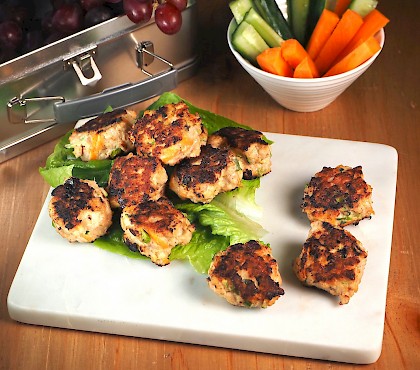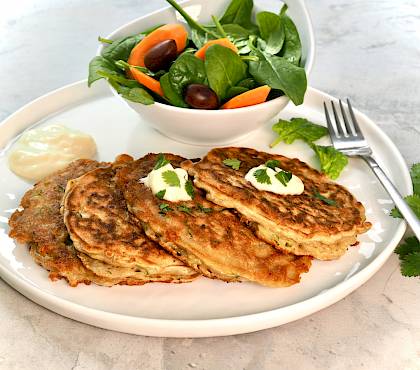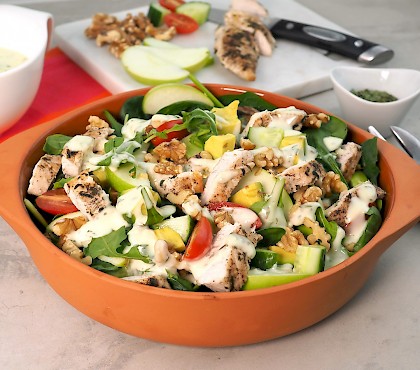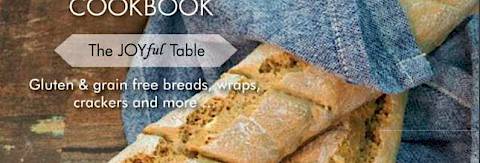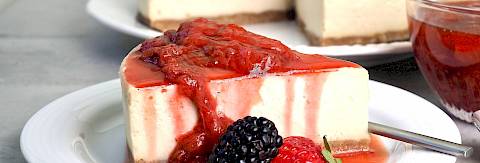
Japanese Savoury Pancakes
- Serves: Makes 8
- Prep Time: 00:15
- Cooking Time: 00:30
Japanese Pancakes (Okonomiyaki) are a popular street food in Japan. These pancakes have a lovely soft centre from the moist vegetables with a firm outside. The main vegetable used in Japanese pancakes is shredded cabbage. I've also added sweet potato to my version to increase the nutrients and fibre, plus I've swapped flour with almond meal and a little arrowroot. They are a light and fluffy savoury pancake. Therefore, don't press down on the mixture when cooking as it will make the pancake dense. You can also add meat or prawns to the mixture but slice it very thinly so it cooks easily. Drizzle with mayonnaise when serving.
Ingredients
* Please click on the green icon next to the ingredients listed below for extra details and helpful information.
- 2 - 3 Tbsp olive oil, or coconut oil for cooking
- BATTER:
- 1 1/2 cups almond meal/flour, (from blanched almonds)
- 1/2 cup arrowroot flour, or tapioca
- 1/2 tsp baking soda (bicarb)
- 1/2 tsp fine sea salt
- 1/3 tsp black pepper, ground
- 1/2 cup chicken broth/stock
- 2 lge egg(s), lightly beaten
- 3 Tbsp coconut aminos
- VEGETABLES:
- 2 1/2 cups finely shredded Chinese cabbage, or 1/4 of a sml Savoy cabbage
- 1 1/2 cups fresh bean sprouts
- 1 sml (approx. 300g) sweet potato(s), grated
- 3 spring onion(s), finely sliced and include some of the green tops
Directions
Add the almond meal, arrowroot, baking soda, salt and pepper to a large bowl. Mix to remove any lumps then make a well in the centre.
Pour in the chicken broth, eggs and coconut aminos. Whisk well to make a smooth batter (the batter will seem a bit thick but some water will start to come out of the cabbage after sitting a few minutes).
Stir in the cabbage, bean sprouts, sweet potato and onions, making sure all vegetables are distributed evenly. The mixture will be more vegetables than batter.
Heat a large 32cm frying pan on medium heat. Add 1 tablespoon of oil and swirl to coat the pan. Add approximately 1/2 cup of the vegetable batter to the pan and spread the vegetables out a little to form a round shape but don't press down as you want a light fully pancake. I find I can cook 3 pancakes at once in my pan. Cover the pan for approximately 5 minutes to allow the vegetables to cook a little. Remove the lid and check the base is golden brown then flip the pancakes over using a large spatula. Add more oil and cook the second side uncovered until golden brown.
Transfer the pancakes to a heat-proof pan and keep warm in a medium oven while cooking the remaining mixture.
Serve drizzled with egg mayonnaise and some extra sliced green tops.
You may also like
olive oil
The olive fruit of the olive tree is pressed and crushed to released the oil. Healthy fats like olive oil are essential for brain function and to transport vitamins and minerals throughout our bodies. This is a delicious oil to drizzled over salads and vegetables.
almond meal/flour
The most favoured gluten/grain free flour substitute in my kitchen is almond meal. It is finely ground blanched almonds and is also known as almond flour. It has a slightly sweet flavour so you don’t have to add as much sweetener when baking with it. Almond meal/flour is rich in manganese which helps the body heal after injuries and also helps the body break down carbohydrates. Almond flour is also rich in magnesium, which can help control your blood sugar levels. It's rich in vitamin E and other antioxidants, which may help reduce the risk of serious health conditions like cancer, diabetes, stroke, and heart disease. Almonds are also a good source of calcium.
All kinds of nuts can be ground down to make a meal and are excellent for raw cheesecake or pie bases. Nut meals/flours are best stored in airtight containers in the fridge or freezer to prevent them going rancid.
arrowroot flour
Arrowroot is a herb, the roots are cultivated for its starch properties. It is used in my recipes as a thickener and I also like combining it with almond meal to produce a much lighter texture, more like a gluten flour. I find the starch helps to bind the ingredients together. You can substitute tapioca flour, which is made from the dried roots of the cassava plant. Tapioca can be used in baking, it has a slightly sweet flavour. However, I do not recommend thickening with tapioca, as it has a stretchy, gummy texture. Supermarkets only sell in very small containers, which is not cost effective. Purchase from baking specialty stores, health food stores or online. ( When substituting for cornflour in recipes, 2 teaspoons arrowroot = 1 tablespoon cornflour/starch).
baking soda (bicarb)
Also known as Bicarbonate of Soda or Sodium Bicarbonate and is used as a rising agent in baking, it contains no gluten or grains. I use Bob's Red Mill baking soda as I find it rises better than other brands I've tried.
sea salt
Organic unbleached, unrefined organic Celtic sea salt or pink Himalayan salt is my salt of choice as these contain healthy minerals and trace elements that our body needs. Regular table salt has been bleached, refined and processed leaving minimal health benefits. If you choose to use regular table salt in my recipes you will need to reduce the quantity or the end result will be to salty.
black pepper, ground
Black and white pepper both come from the fruit of a tropical vine. Black pepper is the cooked and dried unripe fruit, known as a peppercorn and white pepper is from the ripe fruit seed. Pepper is usually coupled with salt, sprinkled over or added to food.
chicken broth/stock
Making homemade chicken broth is a great way to heal Leaky Gut and excellent to drink when unwell. Traditionally broth was made just from bones and simmered for hours to remove the gelatin, marrow and goodness from them. These days vegetables are also added to give extra flavour. By using a slow cooker, making your own broth/stock is so easy. As soon as a roast chicken is eaten, all the bones go into the freezer ready for the next batch of broth. If purchasing store-bought stocks, read the labels as many companies have changed the name of MSG to yeast extract. Organic or free-range brands are available. My Chicken broth recipe is on page 295 of The JOYful Table cookbook. Freeze ice block trays filled with chicken broth for when a small amount is required for a recipe. You can also use an organic concentrated bone broth paste or dehydrated chicken bone broth powder and add them to filtered water.
egg(s)
I have used large free range or organic eggs from a 700g carton in my recipes. Eggs are one of the few foods considered to be a complete protein because they contain all 9 essential amino acids, also studies have shown that lutein (yellow colour) in egg yolks protects against the progress of early heart disease.
coconut aminos
An excellent soy free alternative to soy sauce and tamari. It comes from the sap of the coconut tree and has a sweeter flavour than soy sauce and is not as salty. Coconut aminos can be purchased from health food stores or online. This is one of my favourite ingredients.
Chinese cabbage
Chinese cabbage (or Napa cabbage) is oblong in shape with crisp stems and frilly greenish-yellow leaves. (Napa is a Chinese word that translates roughly as 'leaf'). This cabbage variety is sweet and softer than the regular green cabbage and makes delicious summer salads. It also contains less water than regular cabbage, making it perfect to use in salads to prevent the dressing from being watered down.
bean sprouts
Bean sprouts also know as bean shoots are a common ingredient used in Asian cuisine. Bean shoots are grown from mung bean seeds, they add great flavour and texture to dishes. A great source of dietary fibre, vitamins C and K, protein, magnesium and rich in digestible energy.
sweet potato(s)
Sweet potatoes are a nutrient-dense root vegetable, naturally sweet and high in fibre. They are a rich source of beta carotene (vitamin A), on average one medium sweet potato provides more than 100% of the Recommended Dietary Intake (RDI) for vitamin C. Also high in vitamin E and potassium. Store in a cool place but not in the fridge.
spring onion(s)
Other names for spring onion are scallion or green onion. They have hollow green leaves and a small root bulb and can be eaten raw or cooked. The green tops are also used sliced or chopped as a garnish. The green tops are a good source of vitamin C and beta carotene.



